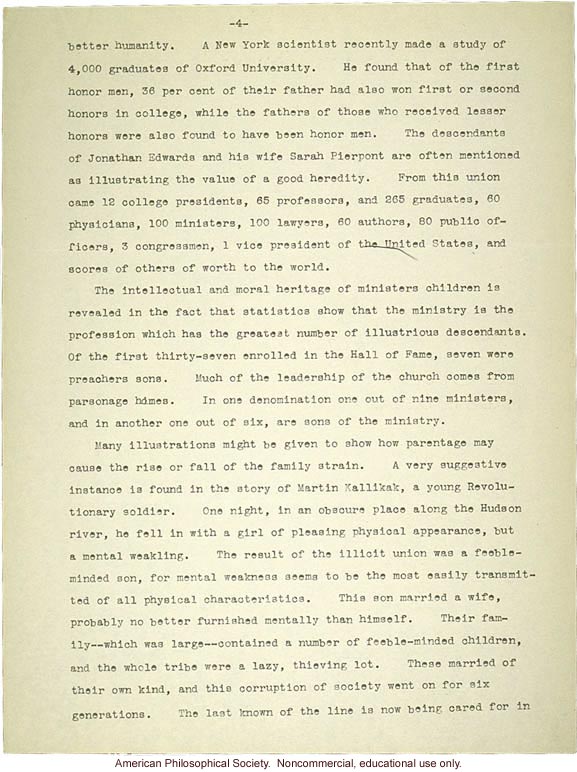Sermon #19 Exerpt, AES Sermon Contest 1926, #2 (1)

Sermon #19 Exerpt, AES Sermon Contest 1926, #2 (1)
779. [page number] -4- [end page number] better humanity. A New York scientist recently made a study of 4,000 graduates of Oxford University. He found that of the first honor men, 36 per cent of their father [sic] had also won first or second honors in college, while the fathers of those who received lesser honors were also found to have been honor men. The descendants of Jonathan Edwards and his wife Sarah Pierpont are often mentioned as illustrating the value of a good heredity. From this union came 12 college presidents, 65 professors, and 265 graduates, 60 physicians, 100 ministers, 100 lawyers, 60 authors, 80 public officers, 3 congressmen, 1 vice president of the United States, and scores of others of worth to the world. The intellectual and moral heritage of ministers children is revealed in the fact that statistics show that the ministry is the profession which has the greatest number of illustrious descendants. Of the first thirty-seven enrolled in the Hall of Fame, seven were preachers sons. Much of the leadership of the church comes from parsonage homes. In one denomination one out of nine ministers, and in another one out of six, are sons of the ministry. Many illustrations might be given to show how parentage may cause the rise or fall of the family strain. A very suggestive instance is found in the story of Martin Kallikak, a young Revolutionary soldier. One night, in an obscure place along the Hudson river, he fell in with a girl of pleasing physical appearance, but a mental weakling. The result of the illicit union was a feeble-minded son, for mental weakness seems to be the most easily transmitted of all physical characteristics. This son married a wife, probably no better furnished mentally than himself. Their family -which was large -contained a number of feeble-minded children, and the whole tribe were a lazy, thieving lot. These married of their own kind, and this corruption of society went on for six generations. The last known of the line is now being cared for in
- ID: 10761
- Source: DNALC.EA


